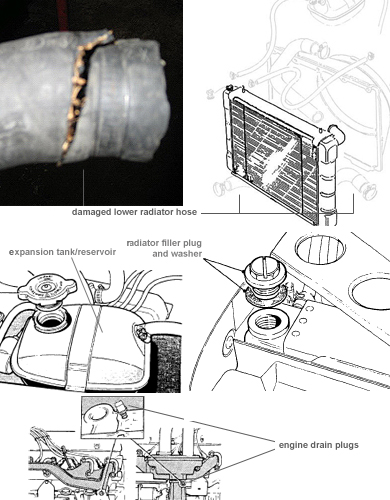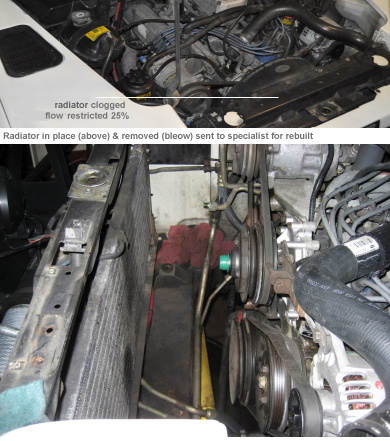 Defender 110 Radiator & Cooling |
|
Radiator and coolant are the most important parts of your NAS Defender's engine cooling system, they protect your engine from overheating. When the cooling system is not serviced regularly or the incorrect coolant additive/mixture (50/50 recommended) is used, rust, scale, and corrosion can occur and result in restricted coolant flow, blocked radiator, overheating, corrosion of metal parts leading to component failure. If Defender overheats, start by checking for radiator and engine block leaks (specially around the head gasket) check fan/clutch operation, thermostat, freeze plugs, and ignition. Your Defender's V8 engine is sensitive to timing that is set too fast a setting of 6 to 12 degrees BTDC (before top dead center) is acceptable. Check timing and make certain that the vacuum advance is working, and not only sucking air. Next, check the thermostat/visco unit. It should lock up when the engine is hot, the clutch should engage, and you should hear the fan "whistle". Maybe a good time to also check your oil cooler lines. Check the coolant pipes running from behind the water pump to the inlet manifold and the heater pipes running from the back of the inlet manifold to the heaterbox - at times they develop a slow leak that will go unnoticed, except when putting strain on the engine. It's not recommended to repair a faulty/stuck thermostat, just buy a new one. To help release the air out of the system, drill a small hole onto the top side of the flange on the thermostat. Check again and check frequently for leaks at the engine plugs, radiator filler plug, expansion tank, over head gasket, all hoses/pipes, make certain the radiator is not obstructed by bugs, mud, debris, etc. Pressure wash is needed. and make certain coolant level and mixture meets manufacturer requirements.
|
Flushing the radiator: Flushing the radiator is an easy task if you have the tools (screwdrivers, pliers, small wrenches/sockets) and basic mechanical skills. You also need antifreeze and a bottle of chemical flush. Any of these items should be available at your local auto parts store. Your radiator should be serviced/flushed every 15000 to 30000 miles. The more frequently the radiator is flushed the less chances of harmful material built-up and consequent failure by partially blocking the flow of coolant to your engine and cooling components. You can send in a blocked radiator to a specialty service center where they will clean, rebuild, pressure-test, and recoat the unit fro you. Draining and filling instructions: Do not remove the radiator filler plug when the engine is hot because the cooling system is pressurized and personal scalding could result. 1) Remove the radiator filler plug. 2) Remove the radiator drain plug and allow the coolant to drain. Once drained refit the drain plug and new washer. The drain plug is located towards the bottom facing the engine compartment. If you don't find one, than simply disconnect the bottom hose and reconnect after draining. 3) Next, remove the engine drain plugs (one each side of the cylinder block, beneath the exhaust manifold). Allow the coolant to drain and refit the plugs and washer. 4) To drain the expansion tank (reservoir) remove it from the vehicle, empty, flush-out and refit. If necessary renew the expansion tank hose. 5) Make up in a canister, the proper coolant mixture/ratio allowing enough for topping up and expansion tank. 50% coolant and 50% distilled water mixture works best for the V8 Defender. 6) Make sure all drain plugs are tight and fill the system through the radiator filler plug until the coolant is just below the filler neck. Fit the plug but do not over tighten. 7) Half fill the expansion tank and secure the cap correctly. 8) start and run the engine until normal operating temperature is reached. Allow the engine to cool and check the levels in the radiator and expansion tank and top up if necessary. Finally check all hose connections for leaks.
|
|
Table of Contents • DefenderHelp.com is an independently owned and operated web site intended to help Defender 110 owners and is not associated with any manufacturer, vendor, or commercial entity unless otherwise mentioned clearly. We do not endorse vendors or products unless we test them, use them, like them, and find sharing the information beneficial to other Defender 110 owners. Visitors may view and use this web site at their own risk. All information and content here is provided for free. All rights reserved. Copyright DefenderHelp.com
|

